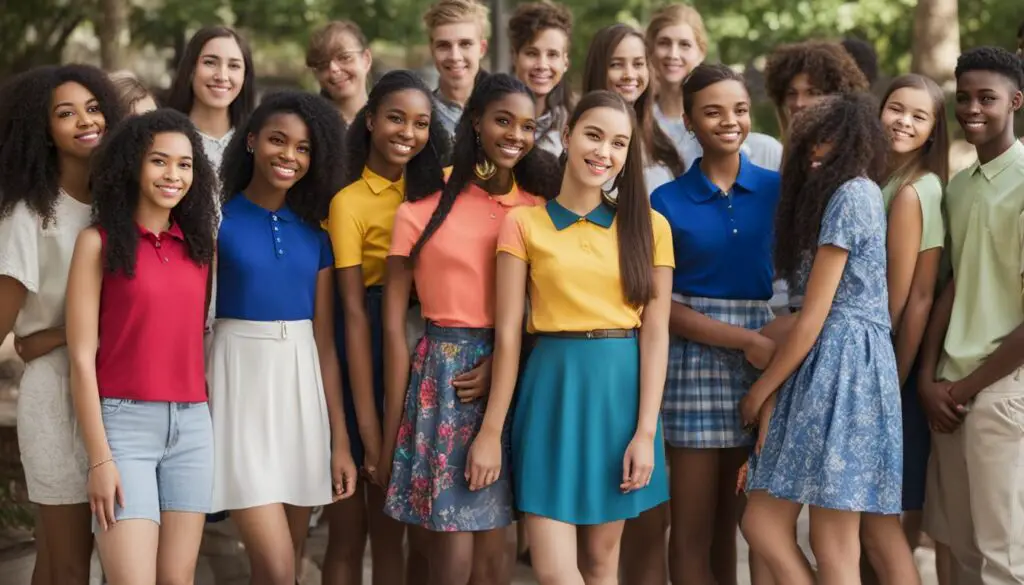Setting group expectations is a crucial aspect of any youth group experience. It provides a framework for behavior and participation, ensuring that both youth and adults understand what is expected of them. By establishing clear and age-appropriate expectations, we create a positive and structured environment where young minds can thrive.
When it comes to setting group expectations, it’s important to use vocabulary that is understood by the specific age group. We want to make sure that the expectations are manageable and relevant to the activities we pursue. Clear and well-communicated expectations help minimize miscommunications and confusion, creating a sense of harmony among youth, parents, and adult volunteers.
Key Takeaways:
- Setting clear group expectations is essential for a positive and productive group experience.
- Involving youth in the process of setting expectations promotes ownership and commitment.
- Consider age-appropriate vocabulary and a manageable number of expectations.
- Regularly revisit and update the expectations to ensure their continued relevance.
- Effective enforcement requires consistent communication and a supportive approach.
Why Setting Group Expectations is Essential
Setting group expectations is essential for creating a positive and productive environment within a youth group. By establishing clear guidelines for behavior and participation, everyone involved can understand what is expected of them and work towards a common goal. The importance of setting group expectations cannot be overstated.
Benefits of setting group expectations:
- Promotes order and structure: Group expectations provide a framework that helps maintain order and structure within the youth group. When everyone knows how they should behave and participate, it creates a sense of clarity and organization.
- Reduces conflicts and miscommunications: Clear expectations ensure that everyone is on the same page, reducing the likelihood of conflicts and misunderstandings. When everyone understands what is expected, it becomes easier to collaborate and support one another.
- Fosters responsible behavior: Setting group expectations promotes accountability and responsibility. Individuals are aware of the consequences of not meeting these expectations, encouraging them to act in a responsible manner.
- Creates a positive atmosphere: Group expectations contribute to a positive atmosphere where everyone feels respected and valued. When expectations are clear, it helps foster a sense of belonging and unity within the youth group.
“Setting group expectations is like laying the foundation for a successful youth group experience. It creates a solid base upon which the group can thrive, ensuring that everyone is working towards a common goal and supporting one another.”
By setting group expectations, youth groups can provide a structured and meaningful experience for their members. It is essential to communicate these expectations clearly and involve the youth in the process whenever possible. With well-defined group expectations in place, both youth and adult volunteers can navigate the group dynamics more effectively, leading to a more fulfilling and impactful youth group experience.
| Benefits of Setting Group Expectations | Key Points |
|---|---|
| Promotes order and structure | Creates a framework for behavior and participation |
| Reduces conflicts and miscommunications | Ensures everyone is on the same page |
| Fosters responsible behavior | Encourages accountability and responsibility |
| Creates a positive atmosphere | Fosters a sense of belonging and unity |
Setting group expectations is like laying the foundation for a successful youth group experience. It creates a solid base upon which the group can thrive, ensuring that everyone is working towards a common goal and supporting one another.

By setting group expectations, youth groups can provide a structured and meaningful experience for their members. It is essential to communicate these expectations clearly and involve the youth in the process whenever possible. With well-defined group expectations in place, both youth and adult volunteers can navigate the group dynamics more effectively, leading to a more fulfilling and impactful youth group experience.
How to Set Group Expectations with Youth
Setting group expectations with youth is a collaborative process that empowers them to take ownership of their behavior and participation in a group setting. By involving youth in the creation of expectations, they feel valued and are more likely to adhere to them. Here are some tips on how to effectively set group expectations with youth:
- Explain the concept: Start by explaining what group expectations are and why they are important. Use simple language and provide examples to help them understand.
- Encourage input: Create an open dialogue where youth can contribute their ideas and suggestions for expectations. This helps them feel heard and increases their sense of responsibility.
- Make it interactive: Make the process fun by using thumbs up/thumbs down gestures to gauge agreement and disagreement with proposed expectations. Allow small teams to come up with their own expectations and present them to the group.
- Provide guidance: Offer words or phrases that can help youth come up with their own expectations, such as safety, teamwork, respect, and participation. This helps them think critically about their behavior and the behavior of others in the group.
By involving youth in the process of setting group expectations, you create a sense of ownership and accountability. This fosters a positive and inclusive group dynamic where everyone is invested in upholding the expectations.
Quote: “When youth are involved in setting the expectations, they are more likely to follow them and understand the impact of their actions on the group.” – Youth Group Leader

| Benefits of Involving Youth in Setting Expectations | Benefits of Adult-Led Expectations |
|---|---|
| 1. Increased sense of responsibility | 1. Clear guidance and direction |
| 2. Enhanced ownership and engagement | 2. Consistency and structure |
| 3. Improved communication and understanding | 3. Authority and respect |
| 4. Empowerment and confidence-building | 4. Experience-based wisdom |
By involving youth in the process, you tap into their unique perspectives and experiences, which enriches the overall group dynamic. It also helps foster their personal growth and development, as they learn to take responsibility for their actions and contribute to a positive group environment.
Key Considerations for Setting Group Expectations
When setting group expectations, it is important to consider various factors to ensure that they are effective and appropriate for the age group. Below are some key considerations:
1. Age-Appropriate Language:
Use vocabulary and language that is easily understood by the youth you are working with. Tailor the expectations to match their developmental stage and ensure clarity in communication.
2. Manageable Number of Expectations:
Be mindful of the number of expectations you establish. For younger youth, it is important to keep the list of expectations manageable, as too many may overwhelm them. Focus on the most important rules that will contribute to a positive group experience.
3. Relevance to the Activity:
Ensure that the expectations you set are relevant to the specific activity or project the group will be engaged in. This helps the youth understand the purpose behind each expectation and reinforces its importance.
4. Conciseness and Clarity:
Keep the expectations short, concise, and easily understandable. Avoid using complicated language or lengthy explanations. Youth would rather spend time on the activity than on setting rules, so make sure the expectations can be quickly grasped.
By considering these factors, you can establish group expectations that are age-appropriate, relevant, and easily understood. This will contribute to a positive and productive group dynamic, ensuring that everyone is on the same page and able to participate fully in the youth group experience.
Example of Youth Group Expectations
Setting clear and age-appropriate expectations for youth groups is crucial for creating a positive and productive environment. Here is an example of youth group expectations that can serve as a guide:
| Expectation | Description |
|---|---|
| Respect | Show respect towards others, including peers, adult volunteers, and property. |
| Participation | Actively engage in group activities and contribute ideas and opinions. |
| Responsibility | Take ownership of personal belongings, follow instructions, and complete assigned tasks. |
| Inclusion | Be inclusive and welcoming to all group members, regardless of differences. |
| Safety | Follow safety guidelines and rules to ensure a secure environment for everyone. |
These expectations provide a foundation for a positive group experience, promoting respect, responsibility, and inclusivity. They also emphasize the importance of active participation and safety, ensuring the well-being of all youth group members.
By having clear and well-defined expectations, youth are encouraged to develop valuable life skills, such as effective communication, teamwork, and accountability. These expectations serve as a guide for behavior and help create a positive and supportive community within the youth group.
Dress Code Expectations for Youth Group
In addition to establishing behavioral expectations, setting dress code expectations is crucial for creating a respectful and professional environment within your youth group. A modest dress code ensures that all participants feel comfortable and valued, promoting inclusivity and reducing potential distractions. By implementing and communicating clear dress code guidelines, you can foster a positive atmosphere where youth can focus on personal growth and meaningful connections.

Guidelines for a Modest Dress Code
When establishing dress code expectations for your youth group, consider implementing the following guidelines:
- Avoid revealing clothing that exposes excessive skin.
- Restrict spaghetti straps or tops with thin straps.
- Ensure appropriate swimwear for outings, adhering to modesty standards.
- Discourage short shorts, mini skirts, or excessively tight clothing.
- Encourage clothing choices that promote comfort and modesty.
Communicate these dress code expectations clearly to all youth and their parents or guardians to avoid any misunderstandings. Consider providing necessary accommodations or resources, such as offering shirts for youth who may not have suitable attire. By setting and enforcing dress code expectations, you can create a welcoming and respectful environment for all participants in your youth group.
Tips for Enforcing Group Expectations
Enforcing group expectations requires effective leadership and communication. When it comes to ensuring compliance with group expectations, consistency is key. Start by consistently reminding the group about the expectations and the importance of following them. This can be done through verbal reminders, written reminders, or a combination of both.
Be proactive in addressing any instances of non-compliance immediately and privately. This allows you to address the issue before it escalates and affects the overall group dynamic. Keep in mind that addressing non-compliance privately helps maintain the individual’s dignity and avoids public embarrassment.
Use positive reinforcement to acknowledge and reward individuals or the group for meeting or exceeding the expectations. This can be done through verbal recognition, small incentives, or a simple appreciation of their efforts. Positive reinforcement not only motivates individuals to continue meeting the expectations but also creates a supportive and encouraging atmosphere within the group.
“Positive reinforcement is a powerful tool that can help individuals stay motivated and engaged. By recognizing and rewarding their efforts to meet the group expectations, you foster a sense of pride and accomplishment.”
Updating and Revisiting Group Expectations
Setting group expectations is not a one-time task but an ongoing process that requires regular updates and revisions. As the youth group evolves and its dynamics change, it is important to revisit the expectations to ensure they remain relevant and effective. By regularly updating the group expectations, you create a sense of adaptability and growth within the group.
When revisiting the group expectations, seek feedback from the members to gain insights into their experiences and perspectives. This feedback can be collected through surveys, group discussions, or one-on-one conversations. By involving the group members in the process, you foster a sense of ownership and empowerment, promoting their engagement and commitment to the expectations.
As you update the group expectations, consider the goals and aspirations of the youth group. Are there new activities or projects that require additional expectations? Are there existing expectations that are no longer relevant or effective? Take the opportunity to align the expectations with the current needs and aspirations of the group.
Benefits of Updating Group Expectations
- Improved effectiveness: Regularly updating the group expectations ensures that they address the current challenges and goals of the youth group, leading to increased effectiveness.
- Enhanced engagement: By involving the group members in the process of updating the expectations, you foster a sense of ownership and engagement within the group.
- Continued relevance: As the youth group evolves, it is crucial to update the expectations to ensure they remain relevant and applicable to the current activities and projects.
- Promotes growth: Updating the group expectations encourages the youth to reflect on their behaviors and take steps towards personal and group growth.
Remember, updating and revisiting group expectations is an ongoing process. By prioritizing this task, you can create a dynamic and thriving youth group environment that fosters positive development and meaningful experiences.
Conclusion
Setting clear and age-appropriate group expectations is crucial for the success of any youth group. By establishing these expectations, both youth and adults can understand their roles, creating a positive and productive atmosphere for everyone involved. The process of involving youth in setting the expectations empowers them to take ownership of their behavior and fosters a sense of responsibility.
Regularly revisiting and updating the group expectations ensures that they remain relevant and effective. By seeking feedback from group members and incorporating their suggestions, you can maintain a sense of inclusivity and adaptability within the group. This approach allows the expectations to evolve alongside the dynamics and goals of the youth group.
Enforcing group expectations requires effective leadership and communication. By consistently reminding the group about the expectations and using positive reinforcement, you can encourage compliance and acknowledge those who exceed the expectations. It is essential to address instances of non-compliance calmly and privately, aiming for understanding and finding solutions together.
With well-defined group expectations in place, you have the opportunity to guide young minds, inspire responsible behavior, and help youth develop into responsible individuals. By setting the foundation for a positive and supportive environment, you create a space where youth can grow, thrive, and contribute to the overall success of the group.
FAQ
Why are group expectations important in a youth group setting?
Group expectations provide structure and order, reduce miscommunications and conflicts, promote responsible behavior, and create a positive and meaningful youth group experience.
How should group expectations be set with youth?
Involve youth in the process, explain the concept of group expectations, encourage their input, make it fun, and use age-appropriate language to ensure understanding.
What are some key considerations for setting group expectations?
Use vocabulary appropriate for the age group, ensure the number of expectations is manageable, make them relevant to the specific activity, and keep them short and concise.
Can you provide an example of youth group expectations?
Sure! Here is a sample set of expectations: safety first, respect others, participate actively, listen to others, and have fun!
What is the importance of dress code expectations in a youth group?
Dress code expectations promote respect and professionalism, create a comfortable environment, and ensure appropriate attire for different activities.
How can group expectations be effectively enforced?
Consistently remind the group about the expectations, address non-compliance privately and immediately, use positive reinforcement, and have respectful conversations with repeat offenders.
Should group expectations be updated and revisited regularly?
Yes, it is important to regularly revisit and update group expectations to ensure their continued relevance and effectiveness as the group evolves.

